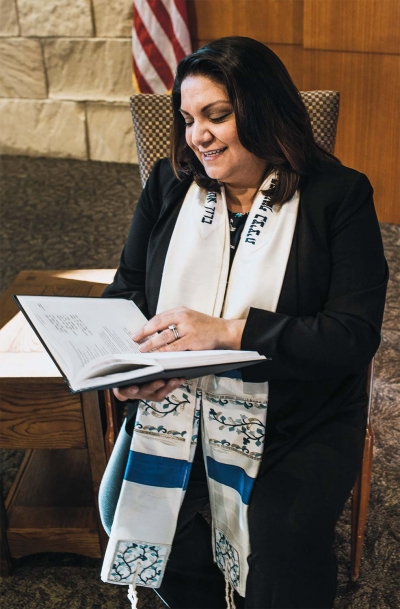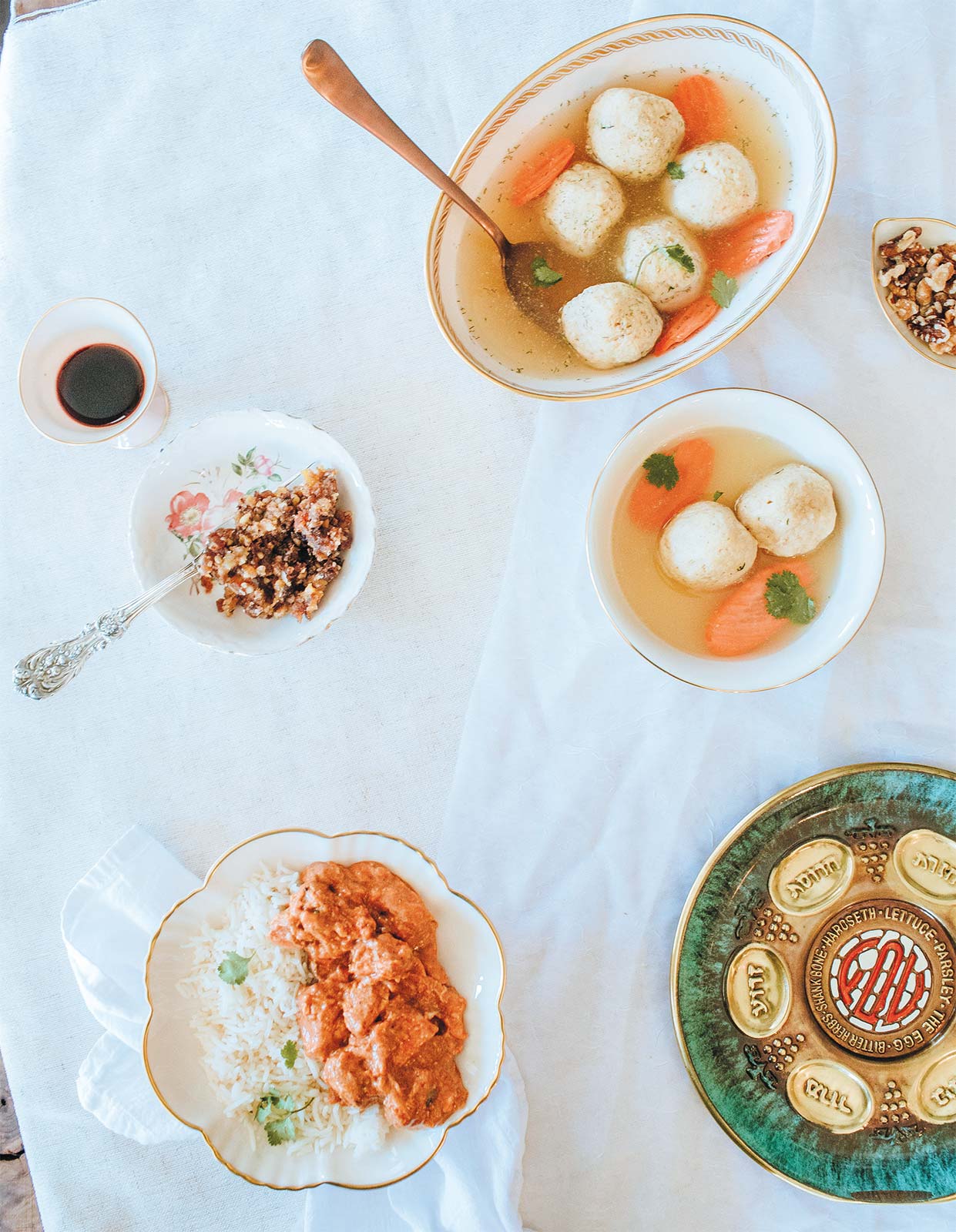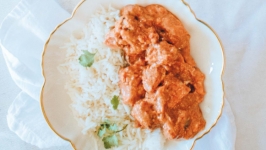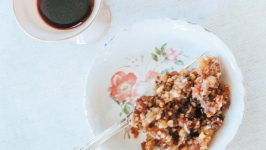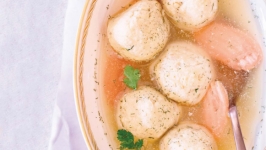FOOD BRIDGES GAPS BETWEEN CULTURES
Welcoming Passover with Cantor Aviva Marer
Glance at the Passover food prepared by Aviva Marer, cantor of Indianapolis Hebrew Congregation, and the bright red chicken curry or the chunky charoset made with dates, dried apricots and cardamom might give you a clue as to her religious background. Cantor Marer’s family hails from a small Jewish Indian sect in New Delhi, known as Bene Israel. But it’s the rice—plain, white and piled next to the curry—that actually tells the story better.
Unlike the Ashkenazi Jews, who come primarily from Europe and do not consider kitniyot—or legumes, grains and seeds—kosher for Passover, the Bene Israel proudly eat rice during the holiday, featuring it prominently in their festival meals.
“Every Passover my father would bring a big plate of rice to the table and just kind of put it down as a marker,” Cantor Marer says, the color of her silk blouse a near-match for her family’s turquoise and gold Seder plate she shows us in a photo. “It was his way of affirming that we eat rice at Passover, and there’s nothing wrong with it. It was kind of who he was.”
It’s kind of who Cantor Marer is, too, as she carries the mantle of her family’s religious traditions into her own vocation as a hazzan, or keeper of traditional music, in her Reform Jewish congregation that values “choice through knowledge with deep respect for tradition and community.”
“I very intentionally share my Indian Judaism,” Cantor Marer says. “I’m always honored when people want to know about it.”
THE JEWS OF INDIA
There are actually three sects of Indian Jews, Cantor Marer explains: The Cochin Jews, which is the oldest sect of Indian Jews emerging from the Cochin region of India. The Baghdadi Jews, who migrated to India from Iraq, Syria, Iran and Afghanistan. And then the Bene Israel Jews, or Sons of Israel, who were kind of a lost tribe for a time.
According to tradition, nearly 2,000 years ago a ship sailing from Palestine wrecked along the rugged Konkan coast of western India. As Cantor Marer tells it, there were 14 survivors, seven men and seven women, who settled in India and continued to practice Jewish customs. Over time, however, they lost sight of the source of those customs. In the 1600s, a Jewish trader from Aleppo discovered the Bene Israel and set about to re-textualize these Indian Jews with the traditional Jewish teachings and festivals.
For centuries, Jews have lived peacefully in India, a religiously diverse culture of Muslims, Hindus, Jains and others. In fact, “India is the only place in the history of the world where there was never any persecution against the Jews,” Cantor Marer says. One reason, she suggests, might be that Indian and Jewish cultures have some similarities. For instance, many Indians don’t eat shellfish or pork, two important omissions of a Jewish kosher or kosher-style diet. The similarities go beyond food, too.
“The cultures blend together pretty seamlessly, too, with the general practice of inner peace, tolerance and treating others the way you want to be treated,” Cantor Marer says.
Despite the lack of persecution, the Jews of India, still small in number, worry about another fate that could cost them just as dearly: that the world will never even know they existed. According to Joan G. Roland in her book Jewish Communities of India: Identity in a Colonial Era, near the turn of the 20th century, some Jews confronted this concern by recommitting to building thriving communities in India. But Cantor Marer’s grandfather, Ezra Kolet, who helped build the first synagogue in New Delhi, encouraged his children to leave India and to carry on the Indian Jewish traditions either in Israel or in North America. According to Cantor Marer, four of Kolet’s children immigrated to Israel and the fifth, Cantor Marer’s father, left India with his wife headed for Canada. They first settled in Toronto, Ontario, eventually making their way to Vancouver, British Columbia.
A NORTH AMERICAN LIFE
While Cantor Marer’s parents wanted their children to have a truly North American life (for instance, they didn’t teach their children Hindi), they also were committed to passing on their Indian Jewish heritage, a balance that felt natural in a country where, according to Cantor Marer, multiculturalism is just a way of life.
“[My upbringing] was so clearly Canadian,” Cantor Marer says. “When you’re in Canada, there’s no push for assimilation. In fact, in Canada diversity is really celebrated. We belonged to an Ashkenazi community, and my mom spent every Friday morning making homemade challah. Then, we would go to synagogue on Friday evenings, and afterwards we ate chicken curry and rice for dinner. We also attended after-school religious school, and we had bar and bat mitzvahs … in Canada. All just part of being Jewish.”
Cantor Marer, who earned an undergraduate degree in classical vocal performance and a master’s degree in choral and orchestral conducting while still in Canada, first came to the United States to attend cantorial school at Hebrew Union College—Jewish Institute of Religion in New York City. After serving as cantor for five years at Temple Emanu-El in Edison, New Jersey, Marer, along with her husband, Jim, a Jew from Argentina, and their son, Benjamin, moved to Indianapolis in June 2018. Here, her Indian Jewish heritage, and also her brown skin, now factor differently in her life.
“Being Jewish is so much of who I am, as a cantor and as a mother, but it also factors into understanding what it is to be different,” Cantor Marer confesses. “I’ve never been more conscious of it until I moved to America. In Canada I feel like everybody comes from a different background. But in America, when you’re not white, it inevitably factors into how you think and how you tell your story.”
TELLING HER STORY
But Cantor Marer does still tell her story. In fact, she’s very passionate about it.
“I guess part of me sees it as honoring my grandfather’s memory in a way,” she says. “When I see all the work he did for his community, I think of it as our obligation to take these stories and bring them forward. Especially in a time when the value of immigrants and immigration patterns are being questioned.”
You might even say that Cantor Marer’s story of arriving here from Canada and her parents’ story of emigrating from India are just an extension of the history of the Jews, who often have been displaced and on the move.
In fact, it’s also the story of Passover, a commemoration of the Jews’ flight from Egyptian slavery, told poignantly through a ceremony of food and wine.
While the Seder is a Jewish ritual, non-Jews are welcome to participate. A key element of most Jewish festivals is the call to practice hospitality and to invite others to the table, both literally and figuratively.
“Food bridges the gap between all cultures and traditions,” Cantor Marer says. “The beauty of the Seder is that it explains everything right in the Haggadah, or order of service. Passover is a very accessible holiday. It’s an easy ritual to involve others in.”
At the same time, inviting others into the story isn’t always easy, Cantor Marer admits, acknowledging that though Jews in India led mostly peaceful lives, persecution has been part of the overall narrative of Judaism.
“Making the choice to be Jewish in a world that is not has to be intentional. It’s a risk,” Cantor Marer says. “But I don’t want to become obsessed with victimization. There’s so much beauty in the world and in our faith, too. It would be unfortunate if it were clouded by fear.”
THE FOOD OF PASSOVER
The Passover Seder, or ceremonial meal, serves as a culinary remembrance of the Jews’ exodus from Egypt aft er generations of slavery. One important ritual of the meal, and of Passover in general, is the removal of any leavening or rising agent not only from the food but also from Jewish homes. This practice commemorates the haste with which Jews were called by God to leave Egypt. According to scriptures, the people didn’t have time even to let their bread rise before they left. Just prior to Passover, Jews make a ceremonial cleaning of the house to be sure all leavening and any foods containing it are removed and either discarded or given away.
During the ceremony, participants eat from a Seder plate, which holds six symbolic foods representing various aspects of the Jews’ slavery and God’s deliverance:
- Zeroa, a shank bone of a lamb or roasted chicken leg bone
- Charoset, a sweet paste made of fruits and nuts
- Maror, or “bitter herbs,” typically red or white horseradish
- Karpas, parsley or any other vegetable
- Beitzah, a roasted hard-boiled egg
- Chazeret, a second bitter herb in the form of a bitter green, often romaine lettuce.
The Seder table also includes a covered plate that holds three pieces of matzah, or crisp unleavened bread; a bowl of salt water; a wine glass for each person and an extra wine glass for Elijah the Prophet.
In Reform Judaism, additional foods have been added to the Seder plate to include social justice themes into the Passover holiday. For example, according to ReformJudaism.org, a whole orange is placed in the middle of the Seder plate to acknowledge the role of marginalized people in the Jewish community, or fair trade chocolate is included as a reminder that forced labor still occurs in the world today.
In the middle of the ceremony, or sometimes aft er the ceremony is over, the host serves a Passover meal, where the foods are kosher for Passover, but don’t individually have the same symbolic significance.


